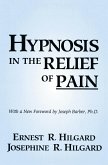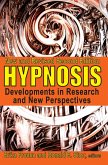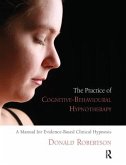- Gebundenes Buch
- Merkliste
- Auf die Merkliste
- Bewerten Bewerten
- Teilen
- Produkt teilen
- Produkterinnerung
- Produkterinnerung
Traces the historical development of hypnosis and provides a review of the theories that have tried to explain how hypnosis works. This book also reflects on the cultural and scientific attitudes and practices that prevailed at various times. It also includes a selection of reports on clinical applications and on legal and forensic issues.
Andere Kunden interessierten sich auch für
![Hypnosis In The Relief Of Pain Hypnosis In The Relief Of Pain]() Ernest R. HilgardHypnosis In The Relief Of Pain75,99 €
Ernest R. HilgardHypnosis In The Relief Of Pain75,99 €![Hypnosis with Children Hypnosis with Children]() Daniel P. KohenHypnosis with Children34,99 €
Daniel P. KohenHypnosis with Children34,99 €![Hypnotherapeutic Techniques Hypnotherapeutic Techniques]() Arreed BarabaszHypnotherapeutic Techniques76,99 €
Arreed BarabaszHypnotherapeutic Techniques76,99 €![Hypnosis Hypnosis]() James W. VanStoneHypnosis114,99 €
James W. VanStoneHypnosis114,99 €![The Practice of Cognitive-Behavioural Hypnotherapy The Practice of Cognitive-Behavioural Hypnotherapy]() Donald J. RobertsonThe Practice of Cognitive-Behavioural Hypnotherapy51,99 €
Donald J. RobertsonThe Practice of Cognitive-Behavioural Hypnotherapy51,99 €![Essentials of Hypnosis Essentials of Hypnosis]() Michael D. YapkoEssentials of Hypnosis35,99 €
Michael D. YapkoEssentials of Hypnosis35,99 €![Hypnosis and Imagination Hypnosis and Imagination]() Robert KunzendorfHypnosis and Imagination66,99 €
Robert KunzendorfHypnosis and Imagination66,99 €-
-
-
Traces the historical development of hypnosis and provides a review of the theories that have tried to explain how hypnosis works. This book also reflects on the cultural and scientific attitudes and practices that prevailed at various times. It also includes a selection of reports on clinical applications and on legal and forensic issues.
Hinweis: Dieser Artikel kann nur an eine deutsche Lieferadresse ausgeliefert werden.
Hinweis: Dieser Artikel kann nur an eine deutsche Lieferadresse ausgeliefert werden.
Produktdetails
- Produktdetails
- The International Library of Psychology
- Verlag: Taylor & Francis Ltd
- Seitenzahl: 522
- Erscheinungstermin: 31. März 2006
- Englisch
- Abmessung: 251mm x 176mm x 44mm
- Gewicht: 1060g
- ISBN-13: 9780754624547
- ISBN-10: 0754624544
- Artikelnr.: 54744325
- Herstellerkennzeichnung
- Produktsicherheitsverantwortliche/r
- Europaallee 1
- 36244 Bad Hersfeld
- gpsr@libri.de
- The International Library of Psychology
- Verlag: Taylor & Francis Ltd
- Seitenzahl: 522
- Erscheinungstermin: 31. März 2006
- Englisch
- Abmessung: 251mm x 176mm x 44mm
- Gewicht: 1060g
- ISBN-13: 9780754624547
- ISBN-10: 0754624544
- Artikelnr.: 54744325
- Herstellerkennzeichnung
- Produktsicherheitsverantwortliche/r
- Europaallee 1
- 36244 Bad Hersfeld
- gpsr@libri.de
Dr Michael Heap is Clinical Forensic Psychologist at Wathwood Hospital, Rotherham, UK. Dr Irving Kirsch is Professor of Psychology at the Department of Psychology, University of Connecticut, USA and the School of Clinical Psychology, University of Plymouth, UK.
Contents: Series preface; Introduction. Part I The Birth of Modern
Hypnosis: Quantitative methods of investigating hypnotic suggestion, Clark
L. Hull; A preface to a theory of hypnotism, Robert W. White. Part II
Theories of Hypnosis: The Altered State Debate: Contributions to
role-taking theory: I hypnotic behaviour, Theodore R. Sarbin; The nature of
hypnosis: artefact and essence, Marin T. Orne; Towards a scientific
explanation of 'hypnotic' behaviour, Theodore X. Barber; Altered states of
awareness, Ernest R. Hilgard; A frontal assault in dissociated control,
Kenneth S. Bowers. Part III Theories of Hypnosis: Divergence and
Convergence: Toward a neo-dissociation theory: multiple cognitive controls
in human functioning, Ernest R. Hilgard; Hypnotic behaviour: a cognitive
social psychological perspective, Nicholas P. Spanos; Response expectancy
as a determinant of experience and behaviour, Irving Kirsch. Part IV
Individual Differences in Hypnotic Suggestibility: The heritability of
hypnotic susceptibility in twins, Arlene H. Morgan; Openness to absorbing
and self-altering experiences ('absorption'), a trait related to hypnotic
susceptibility, Auke Tellegen and Gilbert Atkinson; A social-cognitive
skills approach to the successful modification of hypnotic susceptibility,
Donald R. Gorassini and Nicholas P. Spanos Fantasy-proneness: hypnosis,
developmental antecedents and psychopathology, Steven Jay Lynn and Judith
W. Rhue; On the degree of stability of measured hypnotisability over a
25-year period, Carlo Piccione, Ernest R. Hilgard and Philip G. Zimbardo;
Imaginative suggestibility and hypnotisability, Irving Kirsch and Wayne
Braffman. Part V Investigating Hypnotic Phenomena: Pain and dissociation in
the cold pressor test a study of hypnotic analgesia with 'hidden reports'
through automatic key pressing and automatic talking, Ernest R. Hilgard,
Arlene H. Morgan and Hugh Macdonald; Contextual demands, negative
hallucinations, and hidden observer responding: 3 hidden observers
observed, Nicholas P. Spanos, Deborah M. Flynn and Maxwell I. Gwynn;
Increasing contextual pressures to breach posthypnotic amnesia, William C.
Coe and Anne S.E. Sluis; Hypnotic and posthypnotic suggestion: finding
meaning in the message of the hypnotist, Amanda J. Barnier and Kevin M.
McConkey. Part VI Neuropsychological and Neurophysiological Research and
Theories: Brain dynamics and hypnosis: attentional and disattentional
processes, Helen J. Crawford; Pain affect encoded in human anterior
cingulate but not somatosensory cortex, Pierre Rainville, Gary H. Duncan,
Donald D. Price, Benoît Carrier and M. Catherine Bushnell; A working model
of the neuropsychophysiology of hypnosis: a review of evidence, John
Gruzelier; Psychphysiological correlates of hypnosis and hypnotic
susceptibility, Vilfredo de Pascalis. Part VII Clinical Applications:
Hypnosis: practical applications and theoretical considerations in normal
labour, Mary W. Jenkins and M.H. Pritchard; Hypnosis as an adjunct to
cognitive behavioural psychotherapy: a meta-analysis, Irving Kirsch, Guy
Montgomery and Guy Sapirstein; Long term benefits of hypnotherapy for
irritable bowel syndrome, W.M. Gonsalkorale, V. Miller, A. Afzal and P.J.
Whorwell; Hypnosis and clinical pain, David R. Patterson and Mark P.
Jensen. Part VIII Professional and Legal Issues: Scientific status of
refreshing recollection by the use of hypnosis, American Medical
Association; Recalling the unrecallable: should hypnosis be used to recover
memories in psychotherapy?, Steven Jay Lynn, Timothy G. Lock, Bryan Myers
and David G. Payne; The alleged dangers of stage hypnosis, Michael Heap;
Immediate and persisting effects of misleading questions and hypnosis on
memory reports, Alan Scoboria, Guiliana Mazzoni, Irving Kirsch and Leonard
S. Milling; Name index; Name Index.
Hypnosis: Quantitative methods of investigating hypnotic suggestion, Clark
L. Hull; A preface to a theory of hypnotism, Robert W. White. Part II
Theories of Hypnosis: The Altered State Debate: Contributions to
role-taking theory: I hypnotic behaviour, Theodore R. Sarbin; The nature of
hypnosis: artefact and essence, Marin T. Orne; Towards a scientific
explanation of 'hypnotic' behaviour, Theodore X. Barber; Altered states of
awareness, Ernest R. Hilgard; A frontal assault in dissociated control,
Kenneth S. Bowers. Part III Theories of Hypnosis: Divergence and
Convergence: Toward a neo-dissociation theory: multiple cognitive controls
in human functioning, Ernest R. Hilgard; Hypnotic behaviour: a cognitive
social psychological perspective, Nicholas P. Spanos; Response expectancy
as a determinant of experience and behaviour, Irving Kirsch. Part IV
Individual Differences in Hypnotic Suggestibility: The heritability of
hypnotic susceptibility in twins, Arlene H. Morgan; Openness to absorbing
and self-altering experiences ('absorption'), a trait related to hypnotic
susceptibility, Auke Tellegen and Gilbert Atkinson; A social-cognitive
skills approach to the successful modification of hypnotic susceptibility,
Donald R. Gorassini and Nicholas P. Spanos Fantasy-proneness: hypnosis,
developmental antecedents and psychopathology, Steven Jay Lynn and Judith
W. Rhue; On the degree of stability of measured hypnotisability over a
25-year period, Carlo Piccione, Ernest R. Hilgard and Philip G. Zimbardo;
Imaginative suggestibility and hypnotisability, Irving Kirsch and Wayne
Braffman. Part V Investigating Hypnotic Phenomena: Pain and dissociation in
the cold pressor test a study of hypnotic analgesia with 'hidden reports'
through automatic key pressing and automatic talking, Ernest R. Hilgard,
Arlene H. Morgan and Hugh Macdonald; Contextual demands, negative
hallucinations, and hidden observer responding: 3 hidden observers
observed, Nicholas P. Spanos, Deborah M. Flynn and Maxwell I. Gwynn;
Increasing contextual pressures to breach posthypnotic amnesia, William C.
Coe and Anne S.E. Sluis; Hypnotic and posthypnotic suggestion: finding
meaning in the message of the hypnotist, Amanda J. Barnier and Kevin M.
McConkey. Part VI Neuropsychological and Neurophysiological Research and
Theories: Brain dynamics and hypnosis: attentional and disattentional
processes, Helen J. Crawford; Pain affect encoded in human anterior
cingulate but not somatosensory cortex, Pierre Rainville, Gary H. Duncan,
Donald D. Price, Benoît Carrier and M. Catherine Bushnell; A working model
of the neuropsychophysiology of hypnosis: a review of evidence, John
Gruzelier; Psychphysiological correlates of hypnosis and hypnotic
susceptibility, Vilfredo de Pascalis. Part VII Clinical Applications:
Hypnosis: practical applications and theoretical considerations in normal
labour, Mary W. Jenkins and M.H. Pritchard; Hypnosis as an adjunct to
cognitive behavioural psychotherapy: a meta-analysis, Irving Kirsch, Guy
Montgomery and Guy Sapirstein; Long term benefits of hypnotherapy for
irritable bowel syndrome, W.M. Gonsalkorale, V. Miller, A. Afzal and P.J.
Whorwell; Hypnosis and clinical pain, David R. Patterson and Mark P.
Jensen. Part VIII Professional and Legal Issues: Scientific status of
refreshing recollection by the use of hypnosis, American Medical
Association; Recalling the unrecallable: should hypnosis be used to recover
memories in psychotherapy?, Steven Jay Lynn, Timothy G. Lock, Bryan Myers
and David G. Payne; The alleged dangers of stage hypnosis, Michael Heap;
Immediate and persisting effects of misleading questions and hypnosis on
memory reports, Alan Scoboria, Guiliana Mazzoni, Irving Kirsch and Leonard
S. Milling; Name index; Name Index.
Contents: Series preface; Introduction. Part I The Birth of Modern
Hypnosis: Quantitative methods of investigating hypnotic suggestion, Clark
L. Hull; A preface to a theory of hypnotism, Robert W. White. Part II
Theories of Hypnosis: The Altered State Debate: Contributions to
role-taking theory: I hypnotic behaviour, Theodore R. Sarbin; The nature of
hypnosis: artefact and essence, Marin T. Orne; Towards a scientific
explanation of 'hypnotic' behaviour, Theodore X. Barber; Altered states of
awareness, Ernest R. Hilgard; A frontal assault in dissociated control,
Kenneth S. Bowers. Part III Theories of Hypnosis: Divergence and
Convergence: Toward a neo-dissociation theory: multiple cognitive controls
in human functioning, Ernest R. Hilgard; Hypnotic behaviour: a cognitive
social psychological perspective, Nicholas P. Spanos; Response expectancy
as a determinant of experience and behaviour, Irving Kirsch. Part IV
Individual Differences in Hypnotic Suggestibility: The heritability of
hypnotic susceptibility in twins, Arlene H. Morgan; Openness to absorbing
and self-altering experiences ('absorption'), a trait related to hypnotic
susceptibility, Auke Tellegen and Gilbert Atkinson; A social-cognitive
skills approach to the successful modification of hypnotic susceptibility,
Donald R. Gorassini and Nicholas P. Spanos Fantasy-proneness: hypnosis,
developmental antecedents and psychopathology, Steven Jay Lynn and Judith
W. Rhue; On the degree of stability of measured hypnotisability over a
25-year period, Carlo Piccione, Ernest R. Hilgard and Philip G. Zimbardo;
Imaginative suggestibility and hypnotisability, Irving Kirsch and Wayne
Braffman. Part V Investigating Hypnotic Phenomena: Pain and dissociation in
the cold pressor test a study of hypnotic analgesia with 'hidden reports'
through automatic key pressing and automatic talking, Ernest R. Hilgard,
Arlene H. Morgan and Hugh Macdonald; Contextual demands, negative
hallucinations, and hidden observer responding: 3 hidden observers
observed, Nicholas P. Spanos, Deborah M. Flynn and Maxwell I. Gwynn;
Increasing contextual pressures to breach posthypnotic amnesia, William C.
Coe and Anne S.E. Sluis; Hypnotic and posthypnotic suggestion: finding
meaning in the message of the hypnotist, Amanda J. Barnier and Kevin M.
McConkey. Part VI Neuropsychological and Neurophysiological Research and
Theories: Brain dynamics and hypnosis: attentional and disattentional
processes, Helen J. Crawford; Pain affect encoded in human anterior
cingulate but not somatosensory cortex, Pierre Rainville, Gary H. Duncan,
Donald D. Price, Benoît Carrier and M. Catherine Bushnell; A working model
of the neuropsychophysiology of hypnosis: a review of evidence, John
Gruzelier; Psychphysiological correlates of hypnosis and hypnotic
susceptibility, Vilfredo de Pascalis. Part VII Clinical Applications:
Hypnosis: practical applications and theoretical considerations in normal
labour, Mary W. Jenkins and M.H. Pritchard; Hypnosis as an adjunct to
cognitive behavioural psychotherapy: a meta-analysis, Irving Kirsch, Guy
Montgomery and Guy Sapirstein; Long term benefits of hypnotherapy for
irritable bowel syndrome, W.M. Gonsalkorale, V. Miller, A. Afzal and P.J.
Whorwell; Hypnosis and clinical pain, David R. Patterson and Mark P.
Jensen. Part VIII Professional and Legal Issues: Scientific status of
refreshing recollection by the use of hypnosis, American Medical
Association; Recalling the unrecallable: should hypnosis be used to recover
memories in psychotherapy?, Steven Jay Lynn, Timothy G. Lock, Bryan Myers
and David G. Payne; The alleged dangers of stage hypnosis, Michael Heap;
Immediate and persisting effects of misleading questions and hypnosis on
memory reports, Alan Scoboria, Guiliana Mazzoni, Irving Kirsch and Leonard
S. Milling; Name index; Name Index.
Hypnosis: Quantitative methods of investigating hypnotic suggestion, Clark
L. Hull; A preface to a theory of hypnotism, Robert W. White. Part II
Theories of Hypnosis: The Altered State Debate: Contributions to
role-taking theory: I hypnotic behaviour, Theodore R. Sarbin; The nature of
hypnosis: artefact and essence, Marin T. Orne; Towards a scientific
explanation of 'hypnotic' behaviour, Theodore X. Barber; Altered states of
awareness, Ernest R. Hilgard; A frontal assault in dissociated control,
Kenneth S. Bowers. Part III Theories of Hypnosis: Divergence and
Convergence: Toward a neo-dissociation theory: multiple cognitive controls
in human functioning, Ernest R. Hilgard; Hypnotic behaviour: a cognitive
social psychological perspective, Nicholas P. Spanos; Response expectancy
as a determinant of experience and behaviour, Irving Kirsch. Part IV
Individual Differences in Hypnotic Suggestibility: The heritability of
hypnotic susceptibility in twins, Arlene H. Morgan; Openness to absorbing
and self-altering experiences ('absorption'), a trait related to hypnotic
susceptibility, Auke Tellegen and Gilbert Atkinson; A social-cognitive
skills approach to the successful modification of hypnotic susceptibility,
Donald R. Gorassini and Nicholas P. Spanos Fantasy-proneness: hypnosis,
developmental antecedents and psychopathology, Steven Jay Lynn and Judith
W. Rhue; On the degree of stability of measured hypnotisability over a
25-year period, Carlo Piccione, Ernest R. Hilgard and Philip G. Zimbardo;
Imaginative suggestibility and hypnotisability, Irving Kirsch and Wayne
Braffman. Part V Investigating Hypnotic Phenomena: Pain and dissociation in
the cold pressor test a study of hypnotic analgesia with 'hidden reports'
through automatic key pressing and automatic talking, Ernest R. Hilgard,
Arlene H. Morgan and Hugh Macdonald; Contextual demands, negative
hallucinations, and hidden observer responding: 3 hidden observers
observed, Nicholas P. Spanos, Deborah M. Flynn and Maxwell I. Gwynn;
Increasing contextual pressures to breach posthypnotic amnesia, William C.
Coe and Anne S.E. Sluis; Hypnotic and posthypnotic suggestion: finding
meaning in the message of the hypnotist, Amanda J. Barnier and Kevin M.
McConkey. Part VI Neuropsychological and Neurophysiological Research and
Theories: Brain dynamics and hypnosis: attentional and disattentional
processes, Helen J. Crawford; Pain affect encoded in human anterior
cingulate but not somatosensory cortex, Pierre Rainville, Gary H. Duncan,
Donald D. Price, Benoît Carrier and M. Catherine Bushnell; A working model
of the neuropsychophysiology of hypnosis: a review of evidence, John
Gruzelier; Psychphysiological correlates of hypnosis and hypnotic
susceptibility, Vilfredo de Pascalis. Part VII Clinical Applications:
Hypnosis: practical applications and theoretical considerations in normal
labour, Mary W. Jenkins and M.H. Pritchard; Hypnosis as an adjunct to
cognitive behavioural psychotherapy: a meta-analysis, Irving Kirsch, Guy
Montgomery and Guy Sapirstein; Long term benefits of hypnotherapy for
irritable bowel syndrome, W.M. Gonsalkorale, V. Miller, A. Afzal and P.J.
Whorwell; Hypnosis and clinical pain, David R. Patterson and Mark P.
Jensen. Part VIII Professional and Legal Issues: Scientific status of
refreshing recollection by the use of hypnosis, American Medical
Association; Recalling the unrecallable: should hypnosis be used to recover
memories in psychotherapy?, Steven Jay Lynn, Timothy G. Lock, Bryan Myers
and David G. Payne; The alleged dangers of stage hypnosis, Michael Heap;
Immediate and persisting effects of misleading questions and hypnosis on
memory reports, Alan Scoboria, Guiliana Mazzoni, Irving Kirsch and Leonard
S. Milling; Name index; Name Index.








